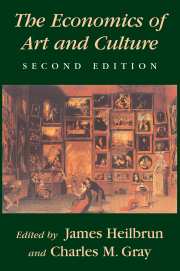Book contents
- Frontmatter
- Contents
- List of figures and tables
- Preface
- Part I The arts sector: Size, growth, and audiences
- Part II The microeconomics of demand and supply
- Part III The fine arts and museums
- Part IV Public policy toward the arts
- 11 Should the government subsidize the arts?
- 12 Public and/or private support for the arts in the United States, Canada, and Western Europe
- 13 Direct public support for the arts in the United States
- Part V Art, economy, and society
- Index
12 - Public and/or private support for the arts in the United States, Canada, and Western Europe
Published online by Cambridge University Press: 05 September 2012
- Frontmatter
- Contents
- List of figures and tables
- Preface
- Part I The arts sector: Size, growth, and audiences
- Part II The microeconomics of demand and supply
- Part III The fine arts and museums
- Part IV Public policy toward the arts
- 11 Should the government subsidize the arts?
- 12 Public and/or private support for the arts in the United States, Canada, and Western Europe
- 13 Direct public support for the arts in the United States
- Part V Art, economy, and society
- Index
Summary
Artistic institutions earn income by selling tickets to performances or, in the case of museums, by charging for admission. But in every economically advanced country, they also receive substantial additional support (the unearned income referred to in Chapter 8) either from the government in the form of grants or from private individuals and businesses in the form of charitable donations. In Western Europe, Canada, and Australia, the additional funding comes largely from the government, whereas the private sector contributes very little. The situation in the United States is just the opposite: Additional support comes mainly from the private sector. There is a lot of history behind this last statement, and it is worthwhile sketching it briefly to explain how we got to where we are now.
TRADITIONAL OPPOSITION TO PUBLIC SUPPORT IN THE UNITED STATES
Until the early 1960s, the federal and state governments in the United States offered virtually no continuous, direct financial support either to artists or to arts institutions, not to the performing arts, not to the fine arts. Although government support for the arts was common-place in Europe, opinion in the United States was quite hostile to the idea. First, until the period of the New Deal in the 1930s, a majority of Americans accepted the philosophy of laissez-faire, according to which government intervention in economic matters should be kept to a minimum. A government that did not subsidize agriculture or housing, provide unemployment insurance to workers, or offer a subsistence income to the poorest of its poor was not going to be asked to subsidize operas, symphony concerts, or ballets.
- Type
- Chapter
- Information
- The Economics of Art and Culture , pp. 250 - 277Publisher: Cambridge University PressPrint publication year: 2001



